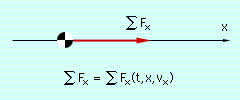| Ch 2. Particle Force and Acceleration | Multimedia Engineering Dynamics | ||||||
|
Rect. Coord. |
Normal/Tang. Coord. |
Polar Coord. |
Orbital Mechanics | Computational Mechanics | |||
| Computational Mechanics | Case Intro | Theory | Case Solution |
| Chapter |
| - Particle - |
| 1. General Motion |
| 2. Force & Accel. |
| 3. Energy |
| 4. Momentum |
| - Rigid Body - |
| 5. General Motion |
| 6. Force & Accel. |
| 7. Energy |
| 8. Momentum |
| 9. 3-D Motion |
| 10. Vibrations |
| Appendix |
| Basic Math |
| Units |
| Basic Dynamics Eqs |
| Sections |
| eBooks |
| Dynamics |
| Fluids |
| Math |
| Mechanics |
| Statics |
| Thermodynamics |
| ©Kurt Gramoll |
|
|
||
|
Until now, the motion of an object was determined using the simple procedure,
In many situations, the functions describing the force (and thus the acceleration) are too complicated to integrate and find closed-form solutions. Approximate solutions can be obtained using numerical integration. |
||
| Finite-Difference Method |
||
 Straight Line Motion |
The finite-difference method is a method of numerical integration that determines changes in dependent variables over finite intervals of time. Consider an object of mass m in straight-line motion along the x-axis. The force acting on the object may depend on time, position, and velocity. The corresponding acceleration will also be a function of time, position, and velocity, and thus cannot easily be integrated to find velocity and position. a = F/m = 1/m ΣFx (t,x,vx) (1) Suppose that at a particular time, to, the position x(to) and velocity vx(to) is known. By definition, the acceleration of the object at to is = 1/m ΣFx(to, x(to), vx(to)) (2) The time derivative of vx at to can be approximated as Substituting this into Eq. 2 gives an approximate expression for the velocity at to + Δt as vx(to + Δt)
= vx(to) The relationship between the velocity and position can be approximated as From this an approximate expression for the position at time to + Δt can be determined as x(to + Δt) = x(to) + vx(to) Δt (4) Thus, if the position and velocity are known at Because of the number of calculations required, this process is greatly simplified with the use of a computer. |
|
| Curvilinear Motion |
||
|
The position and velocity of an object in curvilinear motion can also be determined using the same approach. If an object moves in the x-y plane, the components of force may depend on time, position, and velocity, ΣFx = ΣFx(t,x,y,vx,vy) ΣFy = ΣFy(t,x,y,vx,vy) If the position and time are known at time to, a derivation similar to that for Eqs. 3 and 4 can be used to find the position and velocity at t + Δt. x(to + Δt) = x(to) + vx(to) Δt (5a) y(to + Δt)
= y(to) + vy(to) Δt (5b) |
||
|
vx(to + Δt) = vx(to) + (1/m) ΣFx(to, x(to), y(to), vx(to), vy(to))Δt (5c) vy(to + Δt) = vy(to) + (1/m) ΣFy(to, x(to), y(to), vx(to), vy(to))Δt (5d) |
||
Practice Homework and Test problems now available in the 'Eng Dynamics' mobile app
Includes over 400 free problems with complete detailed solutions.
Available at the Google Play Store and Apple App Store.